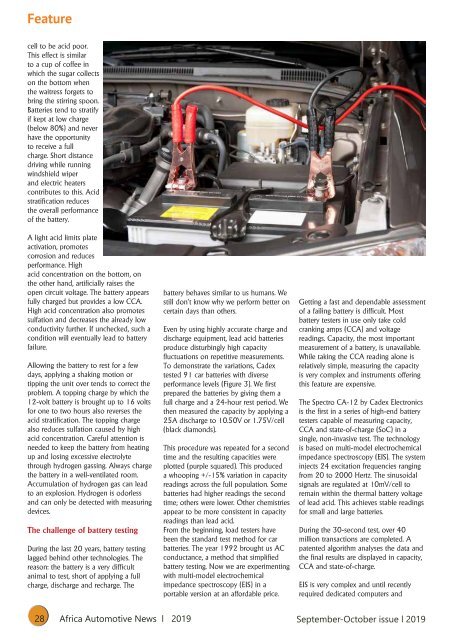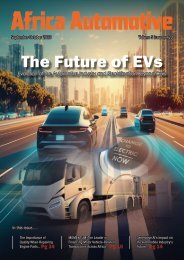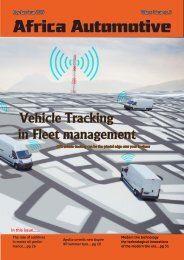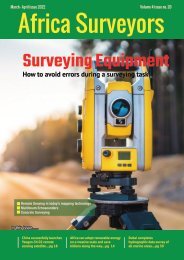Africa Automotive News September-October digital issue 2019
Africa Automotive prides itself to be the ONLY Africa’s leading and MOST authoritative magazine for the automotive industry in Africa with printed copies for the automotive industry decision makers in both government, NGO’s and private sector. The Bi-monthly magazine offers cost effective advertising services that get results and improves growth in the auto B2C and B2B sector, keeping an eye on latest technologies in Africa and across the world, the magazine predominately covers the developments in the Africa auto industry.
Africa Automotive prides itself to be the ONLY Africa’s leading and MOST authoritative magazine for the automotive industry in Africa with printed copies for the automotive industry decision makers in both government, NGO’s and private sector. The Bi-monthly magazine offers cost effective advertising services that get results and improves growth in the auto B2C and B2B sector, keeping an eye on latest technologies in Africa and across the world, the magazine predominately covers the developments in the Africa auto industry.
You also want an ePaper? Increase the reach of your titles
YUMPU automatically turns print PDFs into web optimized ePapers that Google loves.
Feature<br />
cell to be acid poor.<br />
This effect is similar<br />
to a cup of coffee in<br />
which the sugar collects<br />
on the bottom when<br />
the waitress forgets to<br />
bring the stirring spoon.<br />
Batteries tend to stratify<br />
if kept at low charge<br />
(below 80%) and never<br />
have the opportunity<br />
to receive a full<br />
charge. Short distance<br />
driving while running<br />
windshield wiper<br />
and electric heaters<br />
contributes to this. Acid<br />
stratification reduces<br />
the overall performance<br />
of the battery.<br />
A light acid limits plate<br />
activation, promotes<br />
corrosion and reduces<br />
performance. High<br />
acid concentration on the bottom, on<br />
the other hand, artificially raises the<br />
open circuit voltage. The battery appears<br />
fully charged but provides a low CCA.<br />
High acid concentration also promotes<br />
sulfation and decreases the already low<br />
conductivity further. If unchecked, such a<br />
condition will eventually lead to battery<br />
failure.<br />
Allowing the battery to rest for a few<br />
days, applying a shaking motion or<br />
tipping the unit over tends to correct the<br />
problem. A topping charge by which the<br />
12-volt battery is brought up to 16 volts<br />
for one to two hours also reverses the<br />
acid stratification. The topping charge<br />
also reduces sulfation caused by high<br />
acid concentration. Careful attention is<br />
needed to keep the battery from heating<br />
up and losing excessive electrolyte<br />
through hydrogen gassing. Always charge<br />
the battery in a well-ventilated room.<br />
Accumulation of hydrogen gas can lead<br />
to an explosion. Hydrogen is odorless<br />
and can only be detected with measuring<br />
devices.<br />
The challenge of battery testing<br />
During the last 20 years, battery testing<br />
lagged behind other technologies. The<br />
reason: the battery is a very difficult<br />
animal to test, short of applying a full<br />
charge, discharge and recharge. The<br />
battery behaves similar to us humans. We<br />
still don’t know why we perform better on<br />
certain days than others.<br />
Even by using highly accurate charge and<br />
discharge equipment, lead acid batteries<br />
produce disturbingly high capacity<br />
fluctuations on repetitive measurements.<br />
To demonstrate the variations, Cadex<br />
tested 91 car batteries with diverse<br />
performance levels (Figure 3). We first<br />
prepared the batteries by giving them a<br />
full charge and a 24-hour rest period. We<br />
then measured the capacity by applying a<br />
25A discharge to 10.50V or 1.75V/cell<br />
(black diamonds).<br />
This procedure was repeated for a second<br />
time and the resulting capacities were<br />
plotted (purple squared). This produced<br />
a whooping +/-15% variation in capacity<br />
readings across the full population. Some<br />
batteries had higher readings the second<br />
time; others were lower. Other chemistries<br />
appear to be more consistent in capacity<br />
readings than lead acid.<br />
From the beginning, load testers have<br />
been the standard test method for car<br />
batteries. The year 1992 brought us AC<br />
conductance, a method that simplified<br />
battery testing. Now we are experimenting<br />
with multi-model electrochemical<br />
impedance spectroscopy (EIS) in a<br />
portable version at an affordable price.<br />
Getting a fast and dependable assessment<br />
of a failing battery is difficult. Most<br />
battery testers in use only take cold<br />
cranking amps (CCA) and voltage<br />
readings. Capacity, the most important<br />
measurement of a battery, is unavailable.<br />
While taking the CCA reading alone is<br />
relatively simple, measuring the capacity<br />
is very complex and instruments offering<br />
this feature are expensive.<br />
The Spectro CA-12 by Cadex Electronics<br />
is the first in a series of high-end battery<br />
testers capable of measuring capacity,<br />
CCA and state-of-charge (SoC) in a<br />
single, non-invasive test. The technology<br />
is based on multi-model electrochemical<br />
impedance spectroscopy (EIS). The system<br />
injects 24 excitation frequencies ranging<br />
from 20 to 2000 Hertz. The sinusoidal<br />
signals are regulated at 10mV/cell to<br />
remain within the thermal battery voltage<br />
of lead acid. This achieves stable readings<br />
for small and large batteries.<br />
During the 30-second test, over 40<br />
million transactions are completed. A<br />
patented algorithm analyses the data and<br />
the final results are displayed in capacity,<br />
CCA and state-of-charge.<br />
EIS is very complex and until recently<br />
required dedicated computers and<br />
28 <strong>Africa</strong> <strong>Automotive</strong> <strong>News</strong> l <strong>2019</strong> <strong>September</strong>-<strong>October</strong> <strong>issue</strong> l <strong>2019</strong>
















